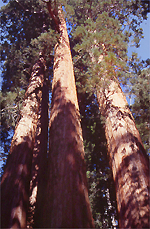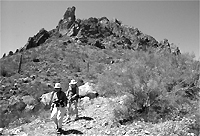|
In her quest for advice on how to manage the country's new monuments, Interior Secretary Gale Norton is looking in all the wrong places. She should try the American public.
By Jenny Coyle
 Hugo Tureck took personal offense when Interior Secretary Gale Norton claimed in March that the Clinton administration failed to include the public in its decisions to designate 19 national monuments and expand three others. Hugo Tureck took personal offense when Interior Secretary Gale Norton claimed in March that the Clinton administration failed to include the public in its decisions to designate 19 national monuments and expand three others.
Now Norton is asking public officials - not the public - how to shrink monument boundaries and include extractive uses.
Tureck, who runs cattle on public lands in Montana and grows wheat and barley on property he owns, chaired the Central Montana Resource Advisory Council (RAC), which studied the best way to protect 377,000 acres of badlands in the state.
"It's a harsh and colorful, semi-arid and brutal landscape," he said. "It's more like being on the ocean than like being on land because of the aloneness that comes with its vastness. I ride my horse out to work cattle in the morning, and it just sweeps me away."
The RAC held three public meetings, met one-on-one with area residents and business people, and gathered 820 pages of written comment and 200 pages of meeting transcripts.
 "Hunters, businessmen, ranchers and backpackers all want this place to remain as wild and free tomorrow as it is today," said Tureck. "In addition, a large number of people who, because of age or other limitations cannot access this area, felt an overwhelming need to tell us how important it is in their lives to know that such places still exist." "Hunters, businessmen, ranchers and backpackers all want this place to remain as wild and free tomorrow as it is today," said Tureck. "In addition, a large number of people who, because of age or other limitations cannot access this area, felt an overwhelming need to tell us how important it is in their lives to know that such places still exist."
The RAC - made up of "15 very different and strong-willed individuals," said Tureck - reviewed the testimony and ultimately recommended that President Clinton designate the Upper Missouri River Breaks National Monument. "This was possible because we respected each other's positions and recognized that we were to reflect the feelings of all Montanans, not those of any one interest group," he said.
Interior Secretary Bruce Babbitt agreed with the committee's recommendation after he held a public meeting in Great Falls with an overflow crowd of 500 people. Clinton designated the national monument on Jan. 17.
The 1906 Antiquities Act gives presidents the authority to designate national monuments. Some of the nation's greatest national parks - Grand Canyon, Zion, Olympic, Bryce Canyon, Glacier Bay, Death Valley, Arches - were originally designated as national monuments by presidential proclamation.
Each designation outlines the resources to be protected and uses that will be allowed; a management plan dictates how that will be accomplished.
 But Norton apparently has other ideas for the new management plans. In March she sent letters to the land managers with jurisdiction over each monument asking whether less - not more - protection might be prudent. "Are there boundary line adjustments the administration should consider recommending?" she asked. "Are there existing uses inside these monuments that we should accommodate? I would like to know your views on vehicle use, access to private inholdings, rights-of-way, grazing, and water rights, as well as the wide spectrum of other traditional multiple uses that might be appropriately applied to these lands." But Norton apparently has other ideas for the new management plans. In March she sent letters to the land managers with jurisdiction over each monument asking whether less - not more - protection might be prudent. "Are there boundary line adjustments the administration should consider recommending?" she asked. "Are there existing uses inside these monuments that we should accommodate? I would like to know your views on vehicle use, access to private inholdings, rights-of-way, grazing, and water rights, as well as the wide spectrum of other traditional multiple uses that might be appropriately applied to these lands."
In a sharply worded reply to Norton, Tureck wrote, "If you negate our lengthy public process with an arbitrary act to alter or eliminate what has already been given to the people, we will have lost forever the chance to preserve this treasure."
And he's not the only one shaken up by the secretary's letter.
Julie Sherman is a Sierra Club organizer working full-time to protect Arizona's five national monuments. Perhaps most at-risk is the 129,000-acre Ironwood National Monument. The problem?
"ASARCO, which already operates a huge copper mine just outside the national monument boundaries," said Sherman. "We understand they want to change the boundaries so they can get at their mining claims within the monument. Norton seems interested in doing that."
Indications are that Rep. Jim Kolbe (R-Ariz.) is anxious to help her. But the Pima and Pinal county boards of supervisors are not. They initiated the national monument process when they passed resolutions asking for the fragile desert land to be protected from sprawl and other threats. "We believe the monument is an appropriate form of protection and should remain without modification or boundary adjustment," the Pima County board wrote in a recent reply to Norton.
The Tucson Arizona Star agreed in an April 8 editorial: "If Norton sincerely wants advice on how to best manage the monument, then Tucsonans will have some good ideas. But if her ultimate goal is to undo all or part of the monument, she should take her act elsewhere."
Sherman and others are ushering members of the public on tours of the state's national monuments, sometimes accompanied by naturalists or archaeologists.
"We've not had one negative response," she said. "People can see for themselves that these lands are precious and deserve protection."
Thirteen of the nation's top environmental groups, including the Sierra Club, sent a letter to Norton on April 23, asking her not to change the new national monuments in any way that would impair their integrity, alter their boundaries or undercut the management prescriptions.
But more action is needed, said Melanie Griffin of the Sierra Club's public lands team.
"Norton will undoubtedly hear from the industry-friendly politicians that we need to shrink the monuments and allow all types of extraction, development and motorized use," she said. "We also believe we'll see legislative attacks in the form of bills, or as riders on spending bills. It's very important that we continue to build a strong record of public support for national monument protection."
Take Action:
Please write Interior Secretary Gale Norton and tell her the national monuments belong to all of us, and you support the designation and want full protection of their biological, cultural and spiritual values. Tell her you don't want to shrink the boundaries of any of the monuments, and you don't want the oil, mining and big agricultural interests dictating decisions about the management of public lands.
Send letters to:
Secretary Gale Norton
c/o Tom Fulton, Office of the Secretary
U.S. Department of the Interior
1849 C Street, NW
Washington, DC 20240
A letter to the editor of your local newspaper would be helpful, too. And if you live in a state with a new monument, send a copy to your governor as well.
Monuments at Risk
Photo (top) courtesy Joe Fontaine, (middle) courtesy Larry Ridenhour, BLM, (bottom) courtesy Dick George.
Up to Top
|